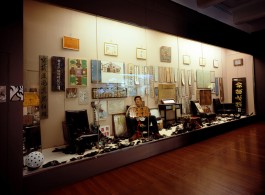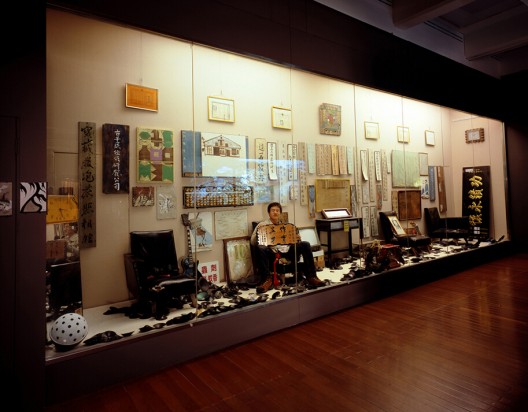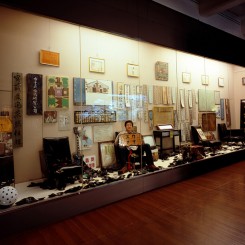Hanart TZ Gallery is pleased to present “Antiquity-like Rubbish Research & Development Syndicate”, a solo exhibition by the internationally renowned Taiwanese contemporary artist Yeh Wei-Li. Known for his photographic and process-based projects, for this exhibition Yeh Wei-Li has created a special installation of his ongoing Antiquity-like Rubbish Research & Development Syndicate, an ambitious project focused on and questioning the concept of “production”. Here Yeh creates numerous pieces of “art” via the collective labor of collecting “junk”, and challenges definitions of what is “junk” or “rubbish” and is “art.” Through his works, lifestyle and working spaces, the Yeh attempts to redefine the meaning of material “junk” within the context of contemporary society and to explore the aesthetic potentiality of the subject. This process-oriented work began in 2010, and it has since materialised in different temporary collaborations involving various forms of production, reflection, and media.
Curatorial Statement Yeh Wei-Li The Entrepreneur: On The Antiquity-like Rubbish Research & Development Syndicate Chang Tsong-Zung
According to Yeh Wei-Li, the invention of the title “Antiquity-Like Rubbish Research & Development Syndicate” was motivated by the need to explain his identity, when someone asked one of his assistants why Yeh was picking through rubbish dumps with his students. It is perhaps because social identity is usually explained by economic relationships, that his assistant described him as an “antique merchant”. As a result, the roles of rubbish, artwork and commodity got bound together: The three roles meet at the cross-section of the art system, because the art system generates value for things that have already been deemed to be without any assured use-value. Although it is not easy to define what type of production “making art” is, the art system certainly has the power to transform something that has lost practical usage into something that deserves attention and perhaps even research, thereby carrying with it innate value and identity. In this roundabout way Yeh Wei-Li’s social identity also transforms from being that of an undescribable someone who picks through rubbish dumps into that of an artist.
Since relocating back to Taiwan from the United States, where he had immigrated at theage of eleven, Yeh Wei-Li has in fact principally concerned himself with constructing hisartistic identity. Over the past decade he has mainly focused on a couple of long-termresearch projects surrounding derelict buildings. To society at large, these architecturalrelics that have managed to survive past their “use by date” are simply due for therubbish dump; their only hope of continued survival, or indeed of any form ofresurrection, is through the attentions of a type of work called “art”. The way economicsociety usually deals with these embarrassing relics is “re-development”; in a case suchas the shanty-town on Treasure Hill, its social value lies in the land the squattersstubbornly occupied, so re-development simply meant demolishment to clear the wayfor economic return. What “Art” tends to treasure, on the other hand, is the alternativespace-time these derelict buildings hold within them, and the dormant life energywaiting to be awakened for today’s nourishment.
There is something quaint about Yeh Wei-Li as an “artist”. He spent almost three diligentyears labouring amidst the ruins of a shanty-town, and at the end of the stay all he had toshow for his troubles were a few dozen photographs. This mode of art productionchanged slightly in the recent Antiquity-like Rubbish Research & Development Syndicate,which adds groups of assemblages created from rubbish objects to the photographicproduction. During school in the United States, Yeh’s passion was photographing rockmusicians, and he realised he could discover greater narrative depth through the chaoticremnants after the concert. On returning to Taiwan, the two major projects he engagedin had to do with abandoned sites that evoke rich historical memories. At the sites ofTreasure Hill and New Day Street, Yeh constructed various spaces for social engagement,including a photography studio, teahouse, archaeological display of found objects and so on; the one rule was that all materials used had to come from the site itself. Having done all this labour intensive work, why did Yeh decide to choose to keep so few images to represent his artwork?
The shift of identity from“rubbish”to “artwork” is triggered by the pivotal figure of the artist, and here his “work” needs examining. As architectural invigoration, Yeh’s building structures are in fact no more than basic constructions, even though they might be charged with robust architectural imagination. As social spaces his teahouse, photography studio and public garden could hardly compete with any normal commercial enterprise. Only the archaeological museum of rubbished relics hints at the secret of art; even so, its location on the site of Treasure Hill made it more a display of local interest for visitors’ attraction than a museum proper. The artistic transformation of the shanty-town was incomplete until the artist photographed his laborious engagements. After Yeh’s departure, the site sank back into oblivion, and all his constructions were either demolished or radically renovated, leaving the scores of photographic images as the only historical evidence of the space having been once upon a time the subject of a utopic endeavor.
The visual memory left behind by photography is not only the inspired moment caught by the camera shutter; it is not about the defining moment that separates it from the infinite moments that come before or after. The gravity of photography lies in its entry into the memory-laden past, to turn the experiential depth of history into an icon of veneration. What the photograph contains is not the completeness of experience, nor therichness of history or complexity of scholarship; what it delivers are regrets andyearnings recorded at that inspired moment, however incomplete it may be asinformation. Yeh’s photographs turn a site anonymous and past its “use by” date into ahistorical place; and yet, the physical geographical places of Treasure Hill and New DayStreet Cinema will never become sites of pilgrimage. As places they can only hope toenter the history of art as memories tied to an artist’s artistic labour.
The enterprise of Yeh’s Antiquity-like Rubbish Research & Development Syndicate, is inspirit a cohort of the enterprise of the anthropological museum. The museum ofanthropology and ethnography takes a limited number of objects as samples forrepresenting entire cultures, and in many cases these objects become the sole evidenceof the existence of extinct civilisations. What moves the audience as aestheticallybeautiful objects probably did not do the same for the peoples who used them as tools orritual objects in the past: It is the detached visual experience of the museum thattransforms them into art. In this way objects unrelated by culture, geography orhierarchy can be compared by ethnographers, or studied for related iconographicpatterns. In a comparable way, the extraction of things from real-life contexts to generatenew significance is also how installation art works in contemporary art. This is howYeh’s “rubbish” may be “researched and developed”. His artwork is not about the way hemakes or alters the installation objects, but in raising the query of identity change, andoffering a solution about how identity gets transformed.
In Yeh’s case, his solution is to equate his personal identity with things discarded andsites abandoned. Through these presences the past can be evoked; but then what theyevoke is the past of other people. Only by imaginative personal engagement, throughlong periods of labour and material involvement, would new utilitarian values and newlife be found for himself. With this labour, the artist rewrites his own history andpersonal identity. From the identity of a returning overseas Taiwanese who, whenabroad, was under pressure to be identified with his Chinese persona, and back inTaiwan is cut off from the discourse of the local art community, Yeh has, through theengagement of old objects and historical places, invented a personal history and identityfor himself. He has adopted himself into certain strains of forgotten and abandonedhistories to claim them for himself. For any person this would also be true, that personalhistories are exclusive, and the past comes alive only with imaginative, laboriousengagement.
As art, Yeh Wei-li’s enterprise is the creation of identities for the ghosts of out-datedthings of the world, and through them finding an identity for himself as an artist ofTaiwan.



